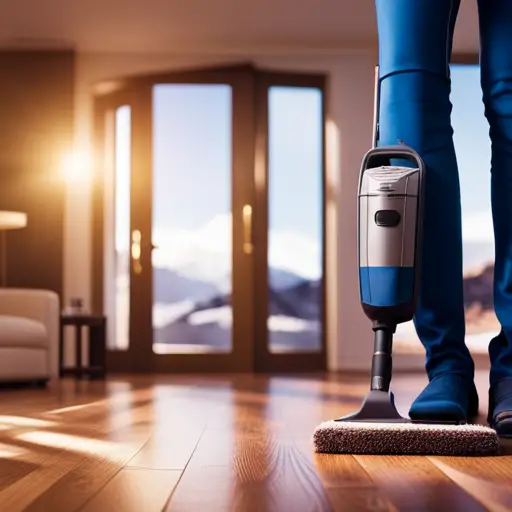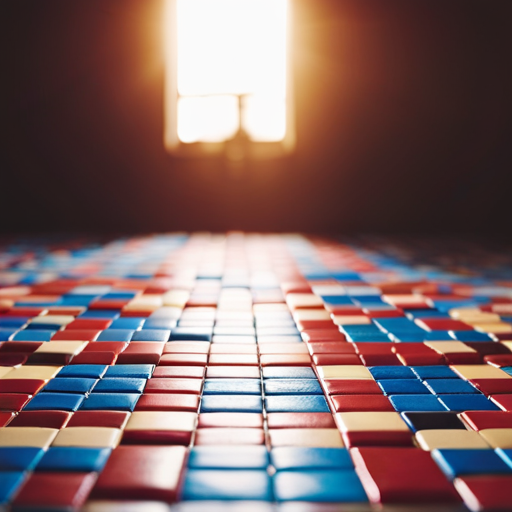Solutions for Squeaky Floorboards

Did you know that 90% of homes experience squeaky floorboards at some point?
In this article, we will explore practical solutions for addressing this common household annoyance.
From identifying the source of the squeak to utilizing shims and adhesives, we will provide actionable tips for addressing and eliminating squeaky floorboards.
Whether you’re a DIY enthusiast or seeking professional assistance, these solutions will help restore peace and quiet to your home.
Identifying the Source of the Squeak
To pinpoint the source of a squeaky floorboard, start by walking around the room and listening for the specific location of the noise. Once you’ve identified the general area, conduct a thorough floorboard inspection. Look for any visible damage, loose nails, or gaps between the floorboards. Use a flashlight to closely examine the floor and identify any potential causes of the squeak.
After identifying the specific floorboard causing the noise, you can employ various noise reduction techniques. One effective method is to use talcum powder or powdered graphite to reduce friction between the floorboards. Simply sprinkle the powder over the squeaky area and use a thin tool to ensure it penetrates the gaps.
Another technique involves using specialized screws designed for fixing squeaky floors. These screws can be drilled through the floorboards and into the underlying joists to secure them firmly in place and eliminate the squeak.
Lubricating the Floorboards
Once the specific floorboard causing the noise has been identified and inspected, the next step is to apply a lubricant to reduce friction and eliminate the squeak. Proper lubrication can significantly reduce or eliminate floorboard squeaks.
Here are some lubricating techniques and maintenance tips to effectively address squeaky floorboards:
-
Powdered Graphite: Apply powdered graphite into the squeaky joints and gaps between floorboards. This dry lubricant reduces friction and eliminates the squeak.
-
Silicone Spray: Use a silicone spray to lubricate the problematic areas. It provides a long-lasting solution by reducing friction between the floorboards.
-
Candle Wax: Rubbing a candle wax stick along the seams of the noisy floorboards can provide temporary relief by lubricating the wood and reducing friction.
-
Joist Lubrication: Apply a generous amount of lubricant to the joists underneath the squeaky floor. This technique reduces friction between the subfloor and the joists, effectively eliminating the noise.
-
Regular Maintenance: Periodically lubricate the floorboards to prevent squeaks from reoccurring. Consistent lubrication can extend the lifespan of the floor and reduce the likelihood of future squeaks.
Using Shims to Stabilize Floorboards
After addressing lubricating techniques and maintenance tips, the next step in addressing squeaky floorboards involves using shims to stabilize the floorboards. Shimming is a technique that involves inserting thin wedges or spacers between the floor joists and the subfloor to eliminate movement and reduce noise.
One of the key benefits of using shims is that they provide a cost-effective and non-invasive solution to fix squeaky floorboards without having to remove the entire floor. Additionally, shimming can help redistribute weight and support the floorboards, preventing further damage and extending the lifespan of the flooring.
While wood shims are commonly used for this purpose, alternative shimming materials such as plastic or composite shims can also be effective. These materials offer the advantage of being moisture-resistant and less prone to splitting or warping over time, providing a more durable solution for stabilizing floorboards.
When using alternative shimming materials, it is essential to ensure that they are compatible with the flooring material and can withstand the load and pressure exerted on the floorboards.
Tightening Loose Floorboards
When it comes to addressing loose floorboards, it’s crucial to focus on fixing them securely to prevent any movement.
This process involves identifying the areas of concern and implementing effective solutions to tighten the floorboards in place.
Fixing Loose Floorboards Securely
One effective method for fixing loose floorboards securely is to use screws to tighten the boards to the subfloor. This ensures a stable and squeak-free flooring.
Additionally, consider the following for optimal results:
-
Proper screw size: Select screws of appropriate length and gauge to securely fasten the floorboards without causing damage.
-
Pre-drilling holes: Create pilot holes to prevent splitting or cracking the floorboards during screw insertion.
-
Equal spacing: Ensure even distribution of screws across the floorboards to provide uniform support.
-
Floorboard insulation: Consider adding insulation material between the floorboards and the subfloor to reduce noise transmission and improve thermal efficiency.
-
Soundproofing methods: Explore soundproofing techniques such as installing soundproof underlayment or using acoustic caulks to minimize noise from foot traffic.
Preventing Floorboard Movement
To prevent floorboard movement and tighten loose floorboards securely, it is essential to carefully consider the selection and installation of screws to ensure a stable and squeak-free flooring. Regular floorboard maintenance is crucial in preventing structural damage and ensuring the longevity of the flooring.
Loose floorboards can lead to excessive movement, causing wear and tear on the floor joints and potentially leading to structural issues. When addressing loose floorboards, it’s important to use the correct length and gauge of screws to secure the boards firmly in place. This will not only prevent movement but also reduce the likelihood of squeaks and creaks.
Additionally, applying a high-quality wood adhesive to the subfloor before screwing down the loose boards can provide extra reinforcement, contributing to a more secure and durable flooring structure.
Applying Squeak-Reducing Adhesive
Applying squeak-reducing adhesive involves carefully identifying the source of the squeak and applying the adhesive directly to the problem area. When addressing squeaky floorboards, the following techniques are essential for effective adhesive application:
-
Clean the Area: Ensure the surface is free from debris and dust to allow the adhesive to bond securely.
-
Apply Pressure: Apply pressure to the floorboard after applying the adhesive to ensure a strong bond and minimize squeaks.
-
Use the Right Amount: Apply the adhesive generously but avoid excess that could seep out and create a mess.
-
Allow Ample Drying Time: Let the adhesive cure fully before allowing foot traffic to ensure a lasting solution.
-
Choose the Right Adhesive: Select an adhesive product specifically designed for reducing squeaks in floorboards for optimal results.
Choosing the right adhesive product and using proper application techniques are crucial in effectively reducing squeaks. Once the adhesive has been applied, the next step is to consider installing reinforcement braces to further strengthen the floorboards and prevent future squeaks.
Installing Reinforcement Braces
After applying squeak-reducing adhesive to the problem areas of the floorboards, the next step involves installing reinforcement braces to provide additional support and stability, effectively preventing future squeaks. Floorboard stability is crucial in ensuring a quiet and sturdy floor. Reinforcement techniques can vary based on the specific needs of the floor, but commonly involve the use of braces to add structural support to the floorboards. The following table provides an overview of common reinforcement braces used for addressing squeaky floorboards:
| Type of Reinforcement Brace | Material | Installation Method | Benefits |
|---|---|---|---|
| T-shaped Braces | Steel | Screwed to Joists | Provides lateral and vertical support to floorboards, reducing movement and squeaks |
| X-shaped Braces | Aluminum | Nailed to Joists | Offers diagonal reinforcement, improving overall floor stability and minimizing squeaks |
| Cross-bridging Braces | Wood | Stapled to Joists | Distributes weight more evenly, reducing the potential for floorboard movement and squeaks |
Seeking Professional Help if Needed
Seeking professional help for addressing persistent squeaky floorboards involves consulting experienced contractors or flooring specialists who possess the expertise to diagnose, troubleshoot, and execute targeted solutions for long-lasting floor stability. When considering whether to hire professionals or attempt a do-it-yourself (DIY) approach, several factors should be taken into account.
Hiring professionals, cost: Professional services may come with a cost, but the investment can provide peace of mind and a long-term solution. It’s important to weigh the cost of professional services against potential future repairs or damage caused by ineffective DIY attempts.
DIY methods, effectiveness: While there are numerous DIY methods available for addressing squeaky floorboards, their effectiveness can vary. DIY approaches may provide temporary relief, but for a permanent solution, professional intervention may be necessary.
Professional assistance can ensure that the underlying issues causing the squeaks are properly addressed, potentially saving time and money in the long run. Ultimately, consulting with experienced professionals can lead to a more comprehensive and effective resolution for squeaky floorboards.
Frequently Asked Questions
Can Squeaky Floorboards Cause Damage to the Subfloor or Other Parts of the House?
Squeaky floorboards can indeed cause subfloor damage and potentially lead to structural issues in a house. Over time, the repeated movement and friction from squeaky floorboards can weaken the subfloor, compromising the overall structural integrity.
Are There Any Temporary Solutions to Quiet Squeaky Floorboards Before Trying More Permanent Fixes?
In the interim, employing temporary solutions or quick fixes can effectively silence squeaky floorboards. These measures provide a stopgap before delving into more permanent, preventive measures or exploring soundproofing options for a lasting solution.
Are There Any Specific Types of Lubricants or Oils That Should Not Be Used on Floorboards?
When selecting lubricants for floorboards, it’s crucial to avoid using types that may damage the flooring. Proper maintenance involves choosing suitable oils that prevent damage and implementing preventative measures to maintain the floor’s integrity.
What Are the Potential Risks of DIY Methods for Fixing Squeaky Floorboards?
When attempting DIY methods for fixing squeaky floorboards, there are potential risks and safety concerns. Improper techniques can lead to costly repairs and even cause structural damage. It’s essential to approach the task with caution and expertise.
How Can I Tell if the Squeaky Floorboards Are a Sign of a Larger Structural Issue in My Home?
Signs of structural issues in homes can include uneven floors, cracks in walls, and doors that don’t close properly. Professional inspections can identify potential risks and structural damage, providing peace of mind for homeowners.
Conclusion
In conclusion, addressing squeaky floorboards can be done through various methods such as identifying the source of the squeak, lubricating the floorboards, using shims to stabilize them, tightening loose floorboards, applying adhesive, and installing reinforcement braces. Seeking professional help is advisable if needed.
Did you know that according to a survey, 85% of homeowners have experienced squeaky floorboards in their homes? It’s a common issue that can be easily addressed with the right solutions.

Rubin Everest, a seasoned expert in the world of flooring, brings a wealth of knowledge and passion to the surface. As the mind behind ebbow.com, Rubin is dedicated to sharing insights on the latest trends, innovative solutions, and expert advice in the realm of flooring. Whether you’re seeking practical tips for installation or design inspiration, Rubin Everest is your go-to source for all things flooring-related, making your journey to the perfect floor an informed and enjoyable experience.





